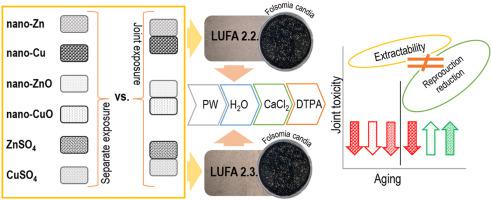Chemosphere ( IF 8.1 ) Pub Date : 2021-09-17 , DOI: 10.1016/j.chemosphere.2021.132252 Izabela Jośko 1 , Patrycja Krasucka 2 , Ewa Skwarek 2 , Patryk Oleszczuk 2 , Mohamed Sheteiwy 3

|
The presence of engineered nanoparticles (ENPs) in soil gradually increases, among others due to the nano-agrochemicals application. So far, the co-existence of different ENPs in soil is poorly examined. Here, the metal extractability and toxicity of soils spiked (300 mg kg−1) singly and jointly with Zn- and Cu-based ENPs or metal salts were tested. The samples were aged for 1 and 90 days. The predicting available metal component of ENPs concentrations were determined by different methods including soil pore water collection and batch extractions with H2O, CaCl2 or DTPA. Survival and reproduction of Folsomia candida were also evaluated. The combined effect of ENPs on the extractability of metals was mainly found with DTPA characterized by the highest leaching capacity among the used extractants. In fresh soil, the mixtures of ENPs differentiated only DTPA-extractable Cu level, while aging resulted in changes in both Zn and Cu concentrations leached by CaCl2 or DTPA. However, the character of the combined effect was an ENPs- and soil type-dependent, whereas the mixtures of metal salts mostly provided higher Zn and Cu recovery than the individual compounds. The pattern of co-toxicity of metal-oxide ENPs was also time-dependent: the antagonistic and synergistic effect was observed in the samples after 1 and 90 days, respectively. However, the toxicity was weakly related with extractable concentrations in both single and joint treatment of metal compounds. The distinct joint effect patterns of ENPs imply the need for more in-depth investigation of mechanisms of activity of ENPs mixtures in soil.
中文翻译:

土壤中锌基和铜基工程纳米粒子的共存:金属可提取性与对念珠菌的毒性
由于纳米农用化学品的应用,土壤中工程纳米粒子 (ENP) 的存在逐渐增加。到目前为止,土壤中不同 ENP 的共存研究很少。在这里,测试了单独或联合添加 Zn 和 Cu 基 ENP 或金属盐的土壤的金属可萃取性和毒性(300 mg kg -1)。样品老化 1 天和 90 天。ENPs 浓度的预测可用金属成分通过不同的方法确定,包括土壤孔隙水收集和使用 H 2 O、CaCl 2或 DTPA 的批量提取。念珠菌的生存与繁殖也进行了评价。ENPs 对金属萃取性的综合影响主要体现在 DTPA 中,DTPA 的特点是在所用萃取剂中具有最高的浸出能力。在新鲜土壤中,ENPs 的混合物仅区分 DTPA 可提取的 Cu 水平,而老化导致 CaCl 2浸出的 Zn 和 Cu 浓度发生变化或 DTPA。然而,组合效应的特征取决于 ENP 和土壤类型,而金属盐的混合物主要提供比单个化合物更高的 Zn 和 Cu 回收率。金属氧化物 ENP 的共毒性模式也与时间有关:分别在 1 天和 90 天后在样品中观察到拮抗和协同作用。然而,在金属化合物的单一和联合处理中,毒性与可提取浓度的相关性较弱。ENPs 独特的联合效应模式意味着需要更深入地研究 ENPs 混合物在土壤中的活性机制。











































 京公网安备 11010802027423号
京公网安备 11010802027423号